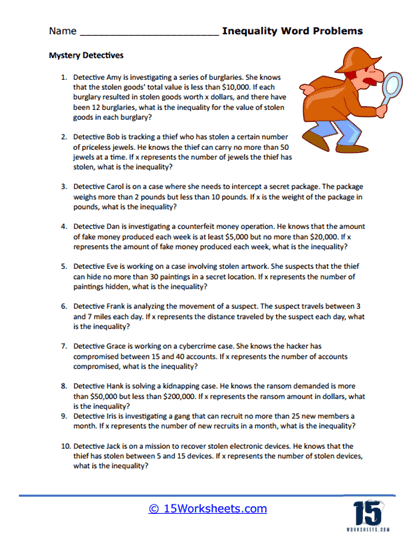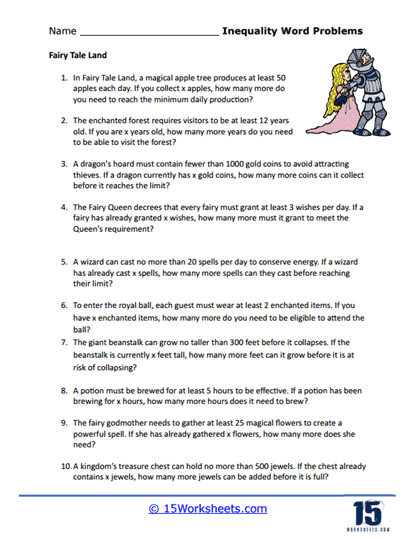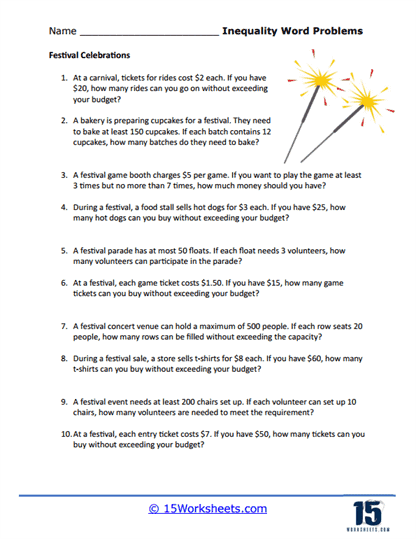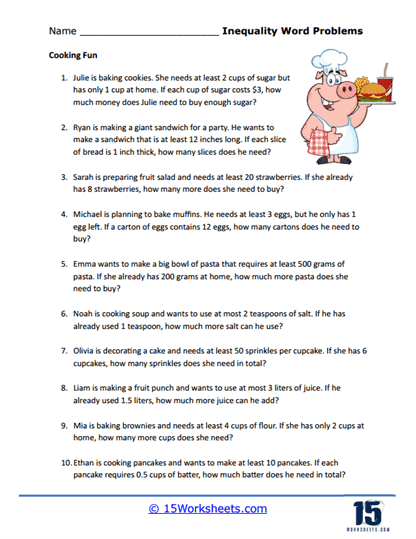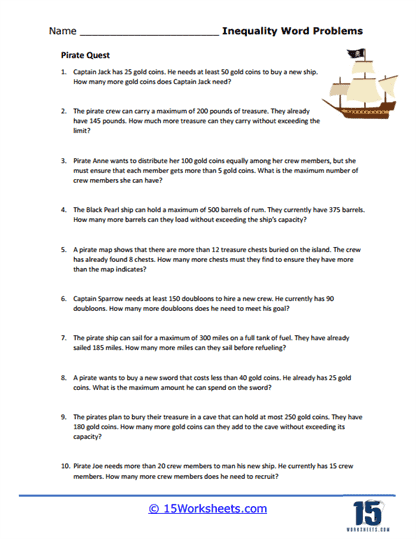Inequalities Worksheets
About Inequality Word Problem Worksheets
Inequality word problem worksheets were developed to help middle school students understand and solve problems involving mathematical inequalities. These worksheets present real-world scenarios that require students to formulate and solve inequalities to find solutions.
Inequalities are mathematical statements that show the relationship between two expressions, indicating whether one is more significant than, less than, greater than, equal to, or less than or equal to another. Mastering inequalities is crucial as it lays the foundation for more advanced algebraic concepts and practical problem-solving skills.
Types of Exercises
Single-variable inequality problem
Students are given a scenario and need to define a variable and set up an inequality to represent the situation. For example, a problem might describe a student needing to earn more than a certain number of points to pass a class. The student would set up an inequality to find the minimum required points.
Compound inequality problems
These involve more complex scenarios requiring students to simultaneously set up and solve two or more inequalities. For instance, a problem could involve a budget constraint where a student has to spend between specific amounts on supplies, necessitating the creation and solution of compound inequalities.
Systems of Inequalities
These exercises present scenarios where multiple conditions must be met simultaneously. For instance, a problem might describe a student planning a party with budget and space constraints, requiring formulating and solving a system of inequalities.
Real-life application problems
Where inequalities are used to model and solve everyday situations, these might include comparing salaries, determining discounts and sales prices, or planning travel schedules. Such problems help students see the relevance of inequalities in their daily lives.
Benefits
These types of word problem worksheets offer numerous benefits, making them essential to middle school math curricula. Firstly, they help students develop critical thinking and problem-solving skills. By interpreting word problems and translating them into mathematical inequalities, students learn to analyze situations, identify relevant information, and devise strategies to find solutions.
Algebraic reasoning
Understanding and solving inequalities requires a solid grasp of algebraic principles, such as manipulating expressions and understanding the properties of inequalities. Regular practice with these problems reinforces these concepts and prepares students for more advanced algebra and calculus courses.
Improved Communication Skills
These types of worksheets often require students to explain their reasoning and justify their solutions. This practice helps students articulate their thought processes clearly and precisely, a crucial skill for success in mathematics and other STEM fields.
Real-world Connections
Many problems are based on practical scenarios, helping students understand how mathematical concepts apply to everyday situations. This relevance can increase students’ interest in mathematics and motivate them to engage more deeply.
Example of an Inequality Word Problem
Jamie is a middle school student who is trying to improve his basketball skills. His goal is to score at least 50 points in his next 5 games. So far, Jamie has scored the following points in his first four games: 8, 12, 9, and 10. How many points does Jamie need to score in his fifth game to reach his goal?
Solution
Step #1 – Identify the Known Quantities
Points scored in the first game: 8
Points scored in the second game: 12
Points scored in the third game: 9
Points scored in the fourth game: 10
Step #2 – Set Up the Inequality
Let x be the points Jamie needs to score in the fifth game to reach his goal of at least 50 points.
The total points scored in 5 games must be at least 50. Thus, we can write the inequality:
8 + 12 + 9 + 10 + x ≥ 50
Step #3 – Simplify the Inequality
Combine the points from the first four games:
8 + 12 + 9 + 10 = 39
So the inequality becomes: 39 + x ≥ 50
Step #4 – Solve for x
Subtract 39 from both sides of the inequality to isolate x:
x ≥ 50 – 39
x ≥ 11
Step #5 – Interpret the Solution
x ≥ 11 means that:
Jamie needs to score at least 11 points (greater than or equal to) in his fifth game to reach his goal of at least 50 points over the 5 games.

